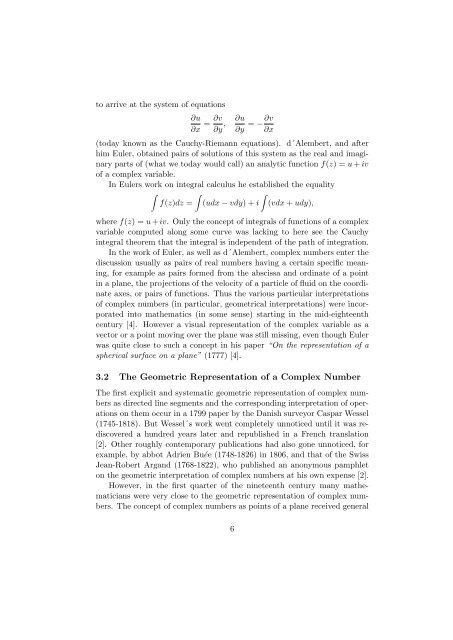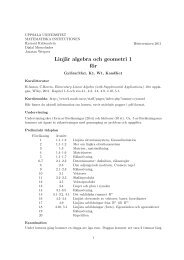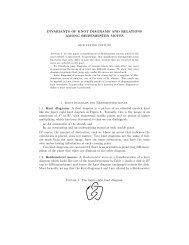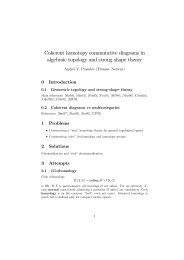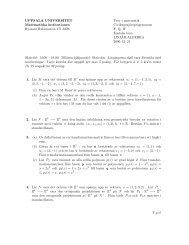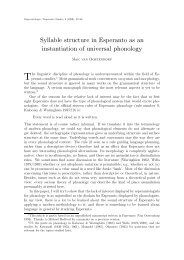Malmsten's Proof of the Integral Theorem
Malmsten's Proof of the Integral Theorem
Malmsten's Proof of the Integral Theorem
- No tags were found...
You also want an ePaper? Increase the reach of your titles
YUMPU automatically turns print PDFs into web optimized ePapers that Google loves.
to arrive at <strong>the</strong> system <strong>of</strong> equations∂u∂x = ∂v∂y ,∂u∂y = − ∂v∂x(today known as <strong>the</strong> Cauchy-Riemann equations). d´Alembert, and afterhim Euler, obtained pairs <strong>of</strong> solutions <strong>of</strong> this system as <strong>the</strong> real and imaginaryparts <strong>of</strong> (what we today would call) an analytic function f(z) = u + iv<strong>of</strong> a complex variable.In Eulers work on integral calculus he established <strong>the</strong> equality∫∫∫f(z)dz = (udx − vdy) + i (vdx + udy),where f(z) = u + iv. Only <strong>the</strong> concept <strong>of</strong> integrals <strong>of</strong> functions <strong>of</strong> a complexvariable computed along some curve was lacking to here see <strong>the</strong> Cauchyintegral <strong>the</strong>orem that <strong>the</strong> integral is independent <strong>of</strong> <strong>the</strong> path <strong>of</strong> integration.In <strong>the</strong> work <strong>of</strong> Euler, as well as d´Alembert, complex numbers enter <strong>the</strong>discussion usually as pairs <strong>of</strong> real numbers having a certain specific meaning,for example as pairs formed from <strong>the</strong> abscissa and ordinate <strong>of</strong> a pointin a plane, <strong>the</strong> projections <strong>of</strong> <strong>the</strong> velocity <strong>of</strong> a particle <strong>of</strong> fluid on <strong>the</strong> coordinateaxes, or pairs <strong>of</strong> functions. Thus <strong>the</strong> various particular interpretations<strong>of</strong> complex numbers (in particular, geometrical interpretations) were incorporatedinto ma<strong>the</strong>matics (in some sense) starting in <strong>the</strong> mid-eighteenthcentury [4]. However a visual representation <strong>of</strong> <strong>the</strong> complex variable as avector or a point moving over <strong>the</strong> plane was still missing, even though Eulerwas quite close to such a concept in his paper “On <strong>the</strong> representation <strong>of</strong> aspherical surface on a plane” (1777) [4].3.2 The Geometric Representation <strong>of</strong> a Complex NumberThe first explicit and systematic geometric representation <strong>of</strong> complex numbersas directed line segments and <strong>the</strong> corresponding interpretation <strong>of</strong> operationson <strong>the</strong>m occur in a 1799 paper by <strong>the</strong> Danish surveyor Caspar Wessel(1745-1818). But Wessel´s work went completely unnoticed until it was rediscovereda hundred years later and republished in a French translation[2]. O<strong>the</strong>r roughly contemporary publications had also gone unnoticed, forexample, by abbot Adrien Buée (1748-1826) in 1806, and that <strong>of</strong> <strong>the</strong> SwissJean-Robert Argand (1768-1822), who published an anonymous pamphleton <strong>the</strong> geometric interpretation <strong>of</strong> complex numbers at his own expense [2].However, in <strong>the</strong> first quarter <strong>of</strong> <strong>the</strong> nineteenth century many ma<strong>the</strong>maticianswere very close to <strong>the</strong> geometric representation <strong>of</strong> complex numbers.The concept <strong>of</strong> complex numbers as points <strong>of</strong> a plane received general6


